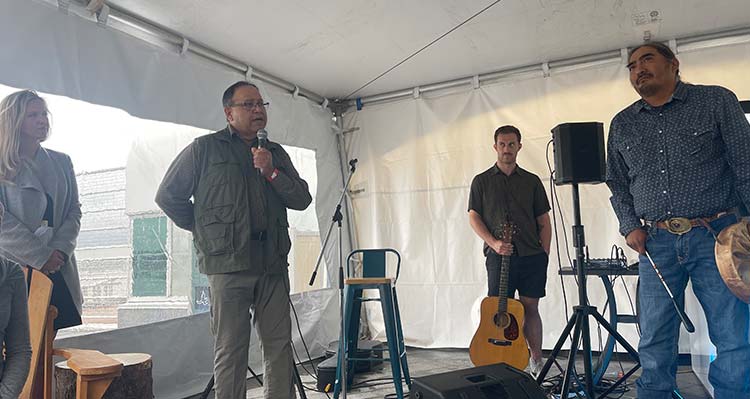Piikani Elder Harley Bastien likes a challenge.
As a self-described custodian of the land, culture and stories of the Piikani First Nation and Blackfoot Confederacy, Bastien was called on to help capture the Canadian Rockies for FlyOver’s Windborne: Call of the Canadian Rockies. The one-of-a-kind problem solving that comes part and parcel with a FlyOver production piqued his interest, and Bastien agreed to come on board as lead Blackfoot advisor.
Bastien helped coordinate several stunning shots for Windborne ’s pre-show and main presentation, including sequences at his own educational tipi camp, Buffalo Rock. Bastien was also instrumental in bringing an Indigenous voice to the film, both in essence through his own advising and literally through his connection to Windborne narrator, fellow Piikani Elder Peter Strikes With A Gun.

Here, Bastien explains what the Rockies mean to him, and his hopes for how Windborne may inspire deeper respect for the land:
“The Rockies, miistákistsi is how we say it in Blackfoot, they're very precious, special and spiritual. They are the source of life, pertaining to the health of the planet. They house a lot of trees, which are the lungs of the planet. They hold a lot of water and snow, which is life-giving to the rest of life as we know it. And in those mountains, I was taught, that’s where the spirits live.
“The spirits that live in the mountains are very powerful, and they keep the life force connected and flowing in a smooth pattern of seasons that come and go. All the creatures, man included, depend on seasons up there. Spring gives medicine, rebirth, renewal. Summer brings ripening, harvesting, warming, maturity. Fall brings the time when the trees go to sleep, the plants go to sleep, the animals prepare for the winter to come — some of the birds migrate, other animals hibernate for the winter. And then the winter itself is a time for calming and peace. In the mountains, it’s a resting time. It’s time for the mountains to collect snow and build up the snowpack and the water that rejuvenates our lakes, rivers and streams.
“All of those that I mentioned, in our way, each one of them has a spirit. Not only human beings have a spirit. All the rest have a spirit — the animals, the birds, the trees, the mountains. They all have a spirit. And it’s very important not to disrupt the spirits up there, because once they are disrupted, that’s when things go in a bad way.
“To me, the most important thing is mountain protection. Human beings are impacting the health of the planet and therefore the health of future generations. You know, the type of people that will stand up for the environment — in this case, the mountains — are people who enjoy nature and have an association and relationship with the mountains, [such as through] going for a hike and enjoying the special healing energies of the mountains.
“For lack of a better phrase, [Windborne] was an opportunity for cultural and environmental awareness. To showcase the beauty of the mountains, the Indigenous perspective on the mountains, in the hopes that more people will realize how special the mountains are and they will do their best to protect them.”
Experience Windborne: Call of the Canadian Rockies, showing December 1 to May 30 at FlyOver Iceland.
Insider tips, inspiration and deals - delivered straight to your inbox.